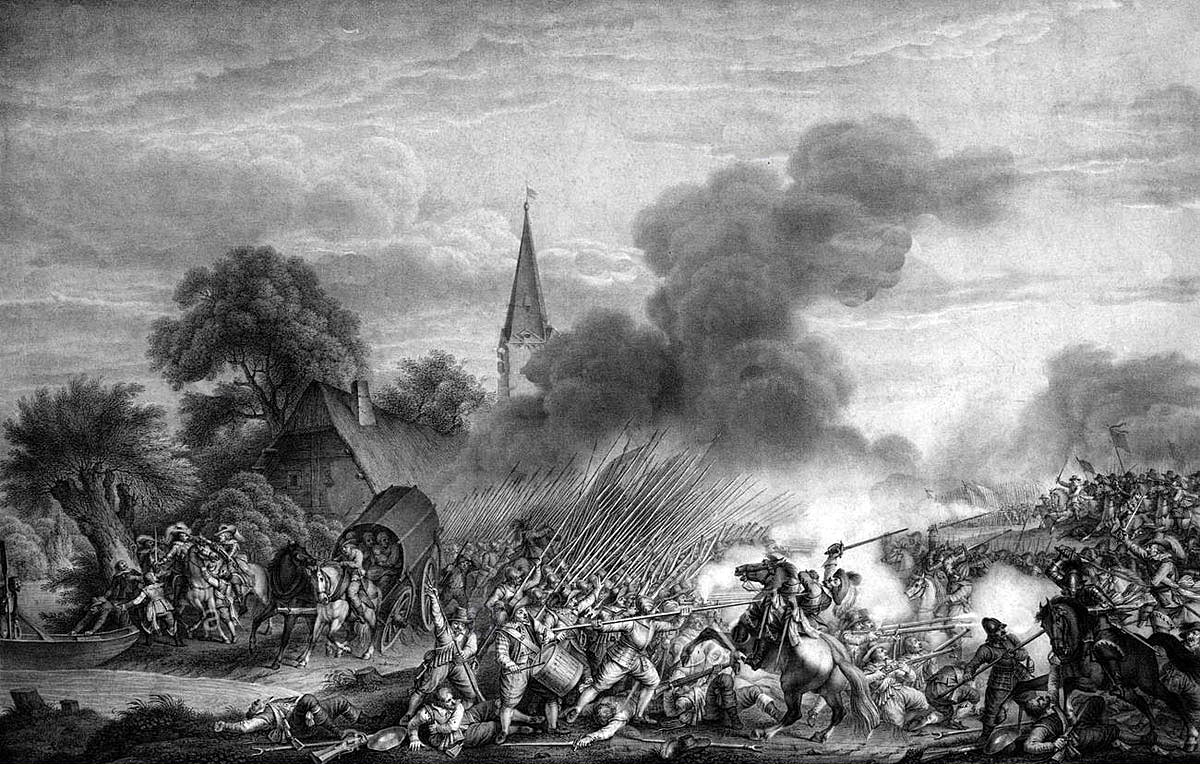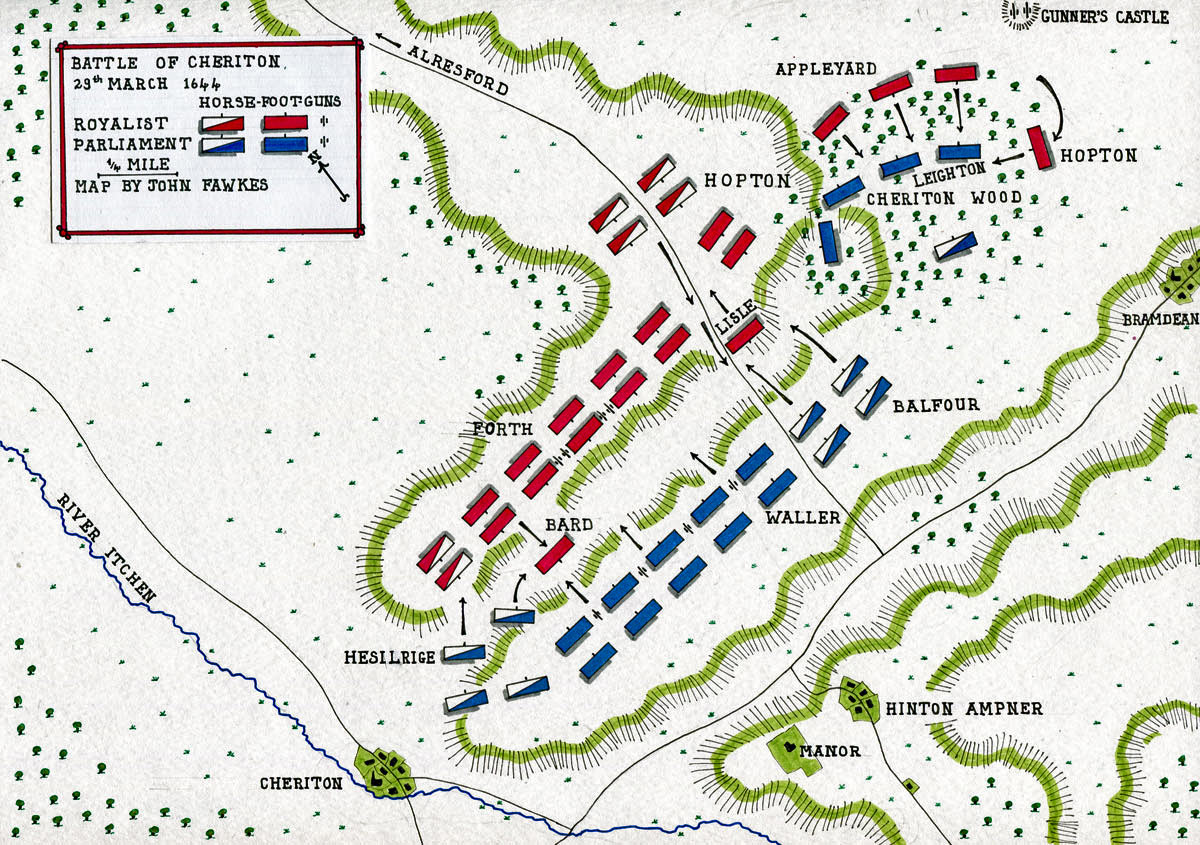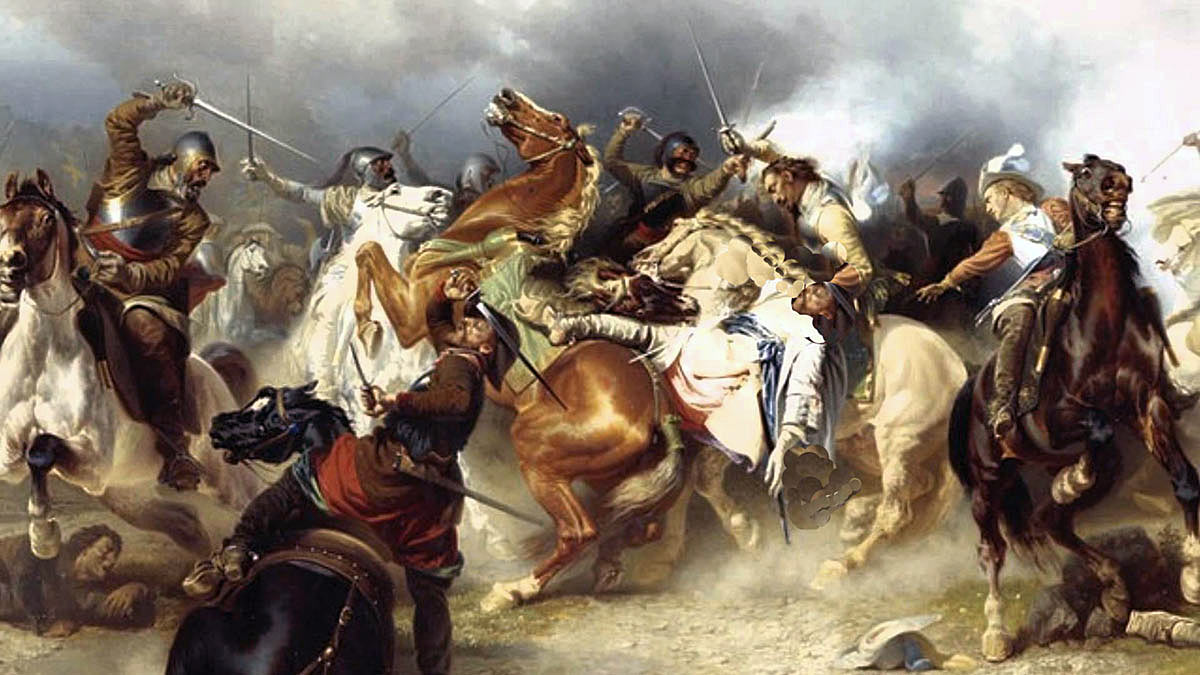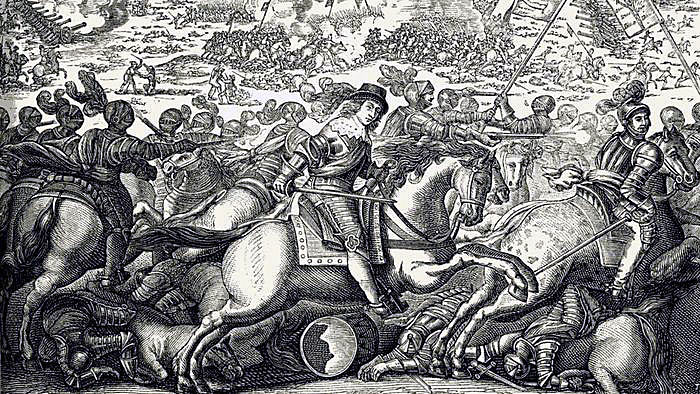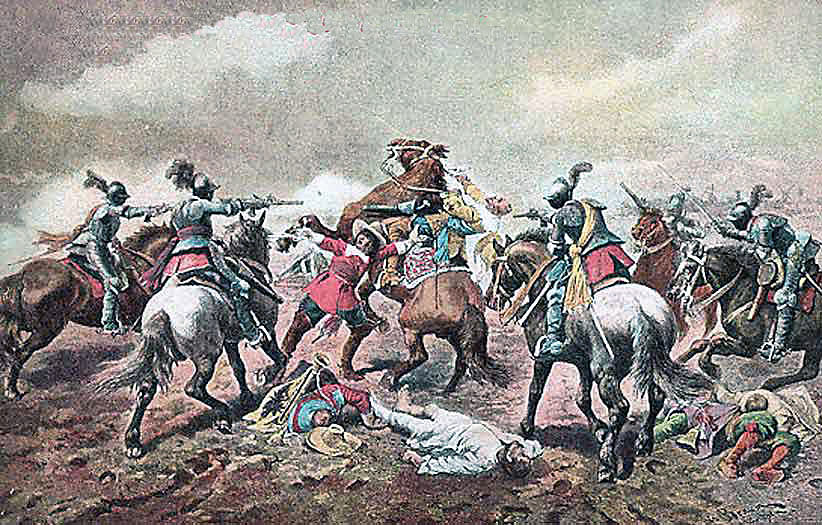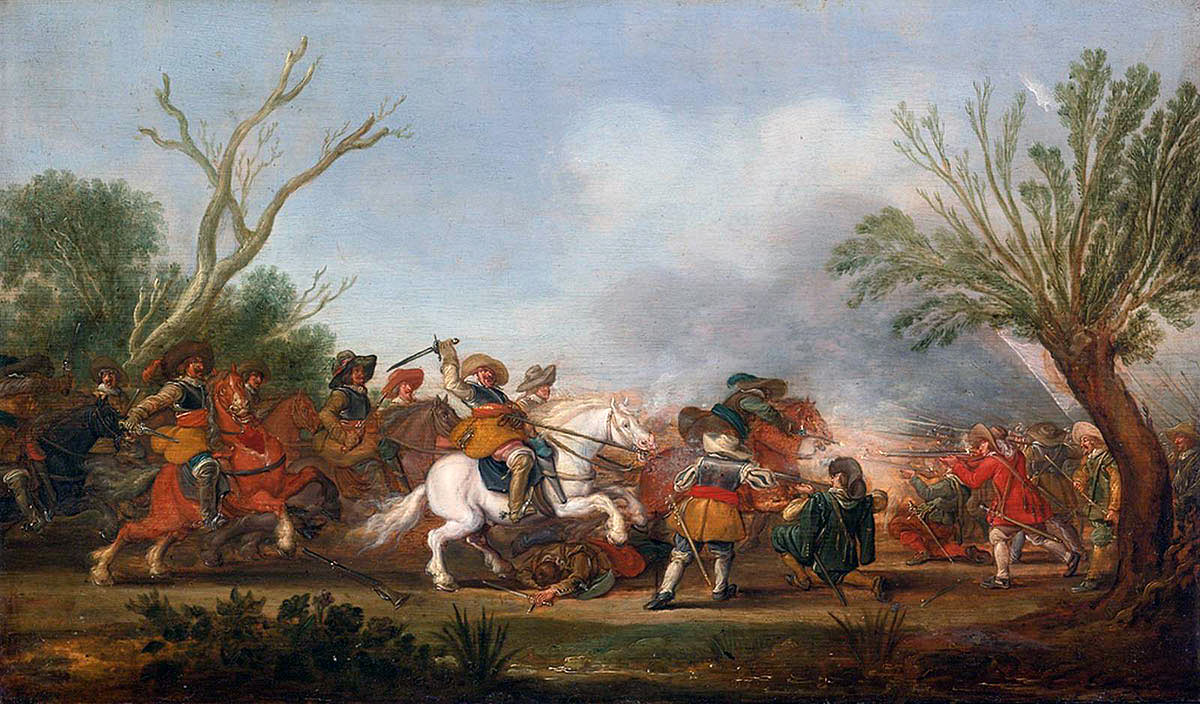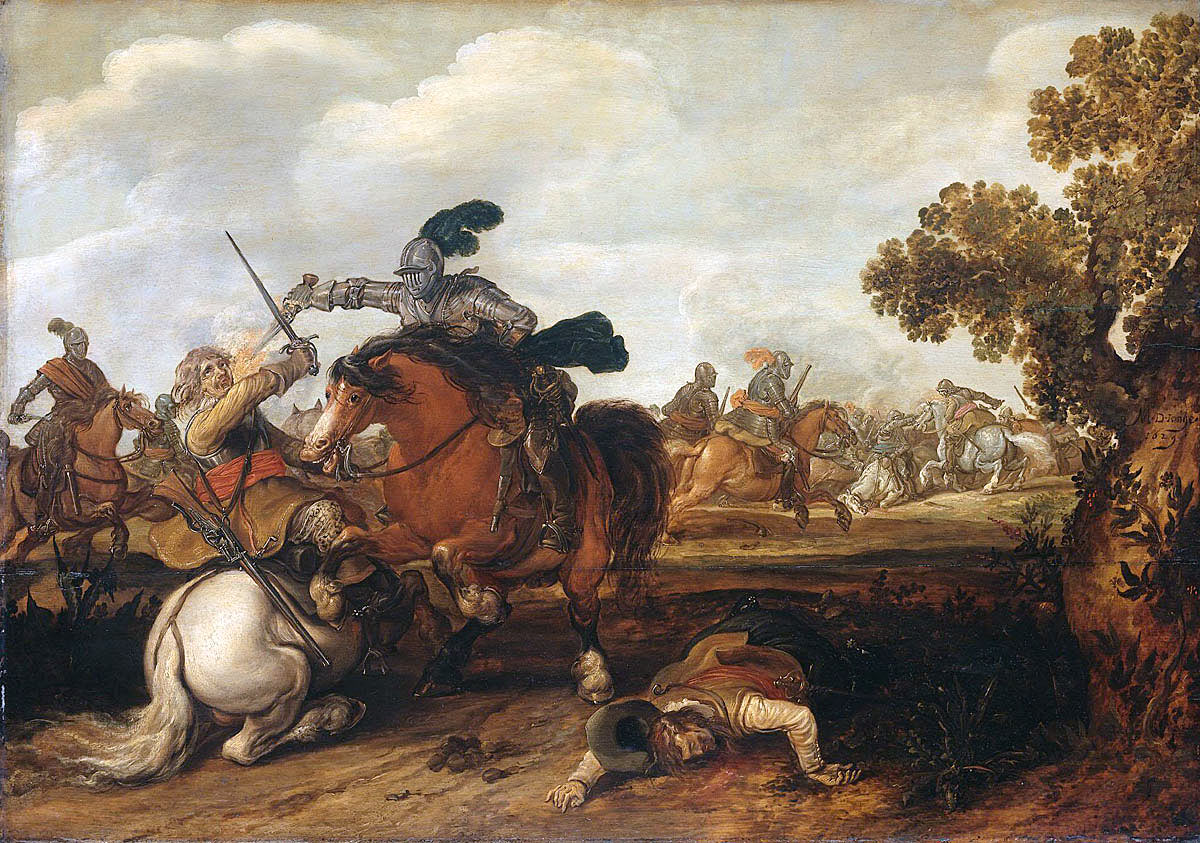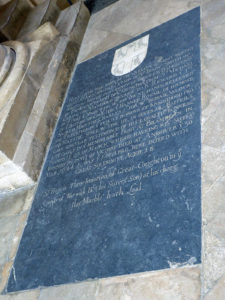A significant Parliamentary victory in the South of England, fought on 29th March 1644
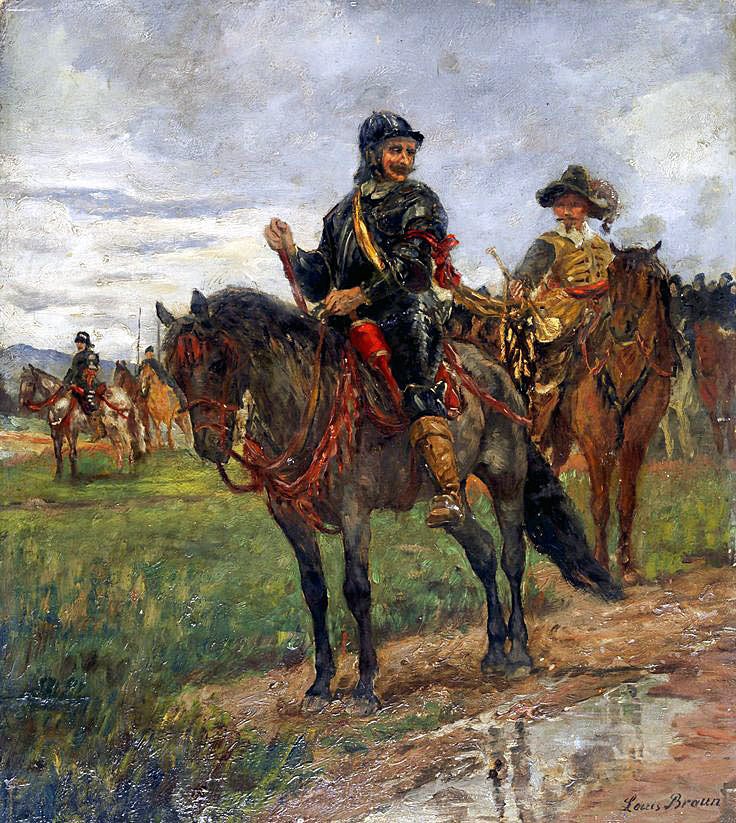
Sir Arthur Heselrige’s ‘Lobsters’, a key regiment in Sir William Waller’s Parliamentary army at the Battle of Cheriton on 29th March 1644; cuirassiers at the time of the English Civil War: picture by Louis Braun
The previous battle in the English Civil War is the First Battle of Newbury
The next battle in the English Civil War is the Battle of Cropredy Bridge
To the English Civil War index
Battle: Cheriton
War: English Civil War
Date of the Battle of Cheriton: 29th March 1644
Place of the Battle of Cheriton: In Hampshire to the east of Winchester
Combatants at the Battle of Cheriton:
The forces of King Charles I against the forces of Parliament.
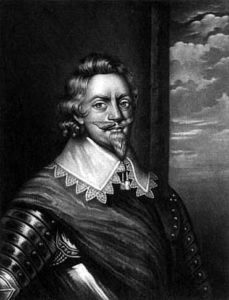
Patrick Ruthven, Earl of Forth, Royalist commander at the Battle of Cheriton on 29th March 1644 in the English Civil War
Generals at the Battle of Cheriton: The Royalist army was commanded by Patrick Ruthven, Lord Forth, and Lord Ralph Hopton.
The army of Parliament was commanded by Sir William Waller.
Size of the armies at the Battle of Cheriton:
The Royalist army was essentially Lord Hopton’s original Western Army. The highly effective Cornish troops had melted away following the death of their main commander Sir Bevil Grenville at the Battle of Lansdown Hill leaving a rump built up with troops raised in Hampshire and Royalist regiments brought over from Ireland.
Patrick Ruthven, Lord Forth brought additional troops from the main Royalist army commanded by King Charles I at Oxford.
The total Royalist army comprised some 3,500 foot and 2,500 horse and dragoons.
Sir William Waller’s Army of the Southern Association lay at Farnham in Surrey. The capture of Arundel Castle by Hopton’s Royalist army encouraged the Parliamentary leaders to provide Waller with two regiments from the London Trained Bands.
Sir William Waller was further reinforced by the arrival from the Earl of Essex’s army in of 3,500 horse and dragoons commanded by Sir William Balfour giving Waller an army of around 5,000 foot and 3,500 horse and dragoons.

Sir William Waller, commander of the Parliamentary army at the Battle of Cheriton on 29th March 1644 in the English Civil War
Winner of the Battle of Cheriton: The Royalist army was decisively defeated.
Uniforms, arms and equipment at the Battle of Cheriton:
See this section in the Battle of Edgehill.
Background to the Battle of Cheriton:
The origins of the English Civil War are dealt with under this section in the Battle of Edgehill.
In late 1643 Lord Hopton advanced from the west taking much of Wiltshire and Hampshire for the King in his advance towards London.
Lord Hopton attempted to bring Sir William Waller’s Parliamentary army to battle but Waller withdrew into Farnham making his headquarters in Farnham Castle.
Hopton executed a surprise march suddenly appearing before Arundel Castle which was surrendered within three days to the alarm of the Parliamentary authorities who had considered the castle to be impregnable.
Leaving a strong garrison at Arundel with strict instructions to provision the castle against Parliamentary attack Lord Hopton’s army went into winter quarters in autumn 1643 in the towns of Winchester, Alton, Petersfield and Alresford.
On 13th December 1643 Sir William Waller attacked the Royalist troops in Alton achieving complete surprise.
The Royalist troops of horse escaped to Winchester while Colonel Bowle’s regiment of infantry attempted to defend themselves in Alton Church. After a fierce fight most of the Royalist foot surrendered while Bowle died fighting.
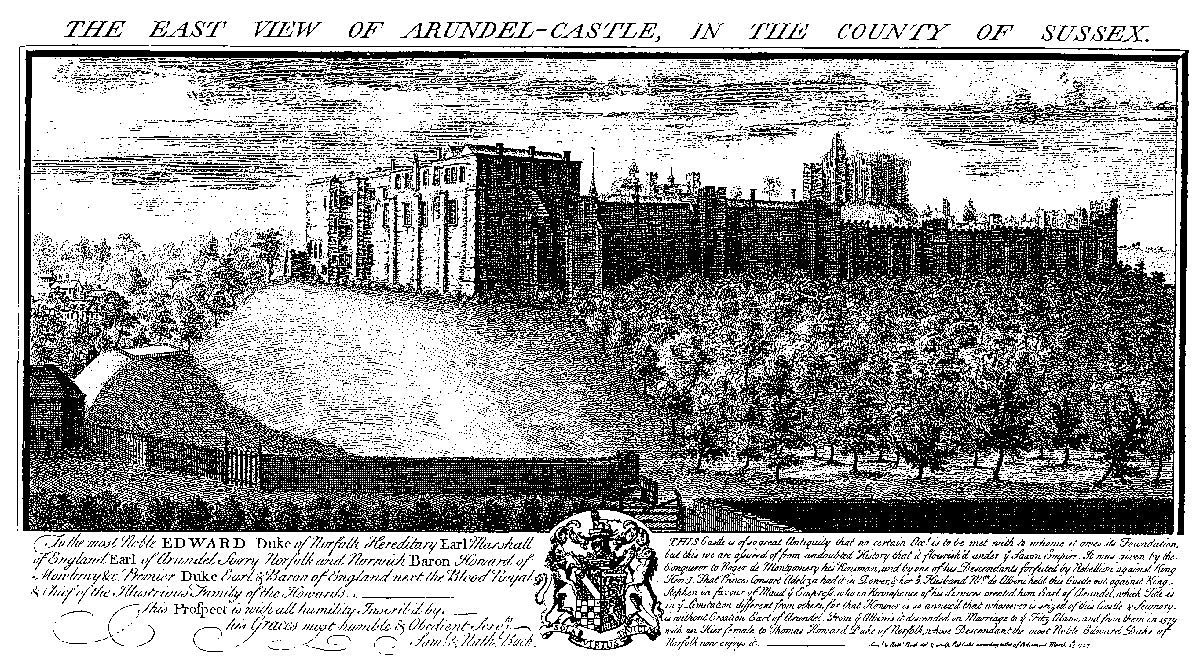
Arundel Castle; captured and re-captured during 1643 and 1644 by Royalist and Parliamentary forces in the English Civil War
Waller followed this success by re-capturing Arundel Castle on 6th January 1643 making 1,000 Royalist soldiers prisoner, many changing sides and joining Parliamentary regiments.
Lord Hopton, following the loss of Bowle’s regiment of foot, one of his best, resolved to bring Waller to battle.
Waller was elated by his successes at Alton and Arundel and intended to make full use of Balfour’s cavalry, which he feared would soon be recalled to Essex’s army, and the two regiments of London Trained Bands to whom he had given undertakings of returning them to London.
With the Royalist re-enforcements sent to the Western Army from Oxford went Patrick Ruthven, Lord Forth, who expressed a wish to visit his old friend from the continental wars, Lord Hopton. Lord Forth held the position of commander-in-chief after the King and so would outrank Hopton.
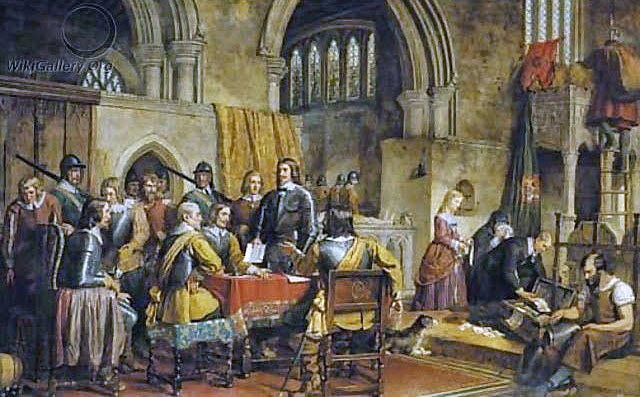
Arundel Castle; captured and re-captured during 1643 and 1644 by Royalist and Parliamentary forces in the English Civil War
Lord Forth marched to Winchester where he found his old friend in an agony of mind over the loss of Bowle’s regiment which he blamed on himself and of Arundel Castle which should have held out for a considerable period.
Forth’s arrival complicated the command of the Royalist army at Winchester. Lord Hopton and Lord Forth were old friends and relations between them were cordial, but Lord Forth was the most senior officer in the Royalist army under the King, while Hopton was only the commander of a regional army.
Lord Hopton sought to defer to Lord Forth and obey his orders, but Lord Forth refused to take overall command saying he would merely accompany Hopton on his campaign and provide him with ‘advice’. Forth frequently gave Hopton ‘advice’ and Hopton took no decision without seeking Forth’s ‘advice’. A pernicious uncertainty took hold in the command structure of the Royalist army.
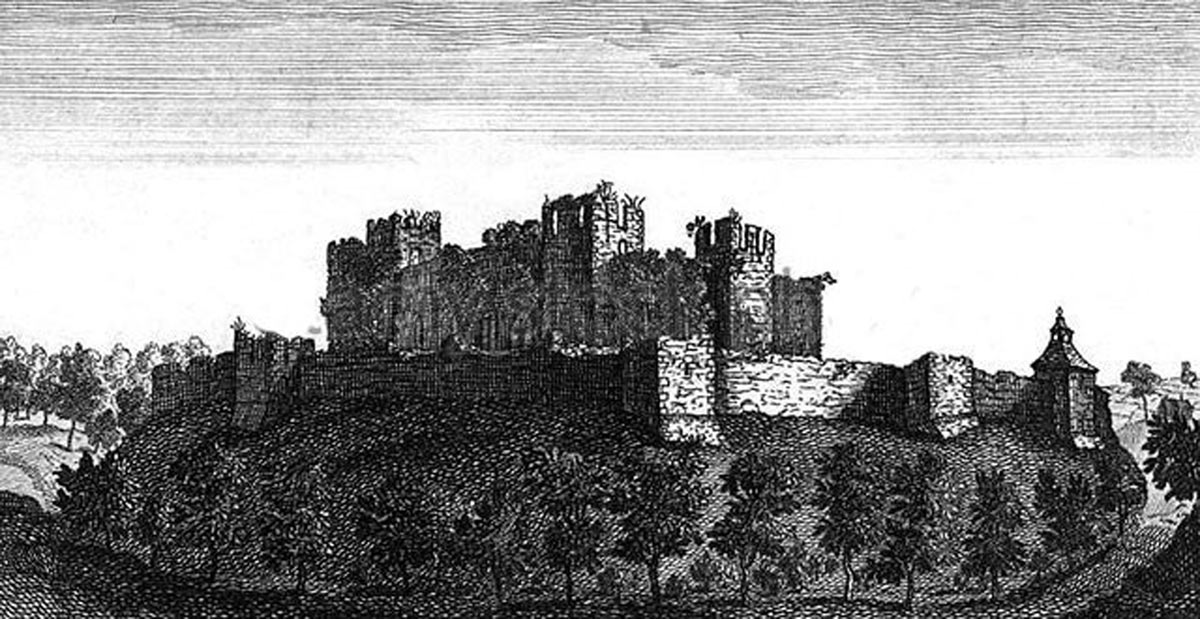
Farnham Castle; Sir William Waller’s headquarters during his campaign in 1643 and 1644 in the English Civil War
Sir William Waller began his advance from Farnham on the Royalist positions in and around Winchester, occupying villages in the Meon Valley.
The Royalist army marched out of Winchester on 26th March 1644 and confronted the London Trained Bands at Warnford. Waller refused to give battle and marched off towards Alresford.
Hopton anticipated Waller’s move and made for Alresford arriving before the Parliamentary army.
While Hopton’s men built defences in Alresford Waller assembled his army outside Alresford on East Down.
Once the rest of the Royalist troops had marched in Hopton’s army encamped on Tichborne Down between Alresford and Cheriton.
Waller’s troops bivouacked along the lane from Hinton Ampner east towards Bramdean, just east of Cheriton.
Waller’s senior officers gathered for a council of war in the Manor House of Hinton Ampner. It was resolved to stand and fight rather than attempt a withdrawal in the face of the Royalist army.
Account of the Battle of Cheriton:
Colonel Sir George Lisle held a Royalist outpost in advance of the main army in the centre of the impending battlefield.
In the dawn of 29th March 1644 Lord Hopton rode forward to Lisle’s position to confirm his suspicion that the Parliamentary army had withdrawn during the night. On the contrary as the mist lifted Waller’s men could be seen falling in for battle on the ridge to the south.
Lord Forth was informed and joined Hopton on Colonel Lisle’s position. Forth ordered Hopton to form the Royalist army along the line of the ridge level with Lisle’s troops who were being compelled to withdraw slightly to avoid being outflanked by the Parliamentary musketeers now taking position in Cheriton Wood.
The Royalist army came onto the battlefield down the track from Alresford. Lord Hopton’s contingent turned to the left and formed for battle on the northern edge of Cheriton Wood, while Lord Forth’s men filed off to the right and took up position on the ridge opposite the gathering Parliamentary horse and foot of Sir William Waller’s left wing.
Waller’s army had been deploying since dawn. 1,000 musketeers commanded by Colonel Leighton and supported by 300 Horse advanced into Cheriton Wood while the rest of the army, foot, horse and guns moved forward onto the ridge running east from Cheriton.
The Parliamentary horse and dragoons on the left were commanded by Sir Arthur Heselrige, colonel of the cuirassiers known as the ‘London Lobsters’ and on the right by the Sir William Balfour.
The Royalist army was in position on the ridge facing the Parliamentary army on the other side of the valley by the end of the morning.
The Royalist attack was initiated by an assault on Cheriton Wood by four columns of musketeers commanded by Colonel Matthew Appleyard. As they advanced the Royalists musketeers came under attack and halted to conduct a vigorous fire fight with their opponents.
To break the deadlock in the Royalist attack on Cheriton Wood Lord Hopton directed Lieutenant Colonel Edward Hopton to move his column around the wood and attack the Parliamentary force in flank, with the support by the Royalist guns in the ‘Gunner’s Castle’.
Colonel Hopton’s musketeers gave one volley from a hedge throwing Leighton’s Parliamentary musketeers into confusion. Appleyard’s whole force stormed into the wood, driving out their Parliamentary adversaries and inflicting many casualties. This success in Cheriton Wood gave the Royalists the whole ridge and was the opportunity to exploit their success and extend the attack. But Lord Forth’s advice was now to stay on the defensive along the ridge and allow the Parliamentary army to carry out any offensive moves.
Lord Hopton was riding along the Royalist line from left to right when he saw that there was heavy fighting in front of the Royalist right in the valley between the two ridges.
A young Royalist regimental commander, Colonel Henry Bard, had led his regiment of foot into the attack from the Royalist right. Bard was acting without orders, but may not have received the specific direction to remain on the defensive. Certainly his actions were rash in the extreme whatever his understanding of his duty. He was taking his regiment unsupported on either flank into the area between the two armies.
Waller had already ordered the cavalry of his left wing to move forward and cover the flank of his army. Seeing Bard’s Royalist foot moving forward Sir Arthur Heselrige directed 300 of his horse to attack Bard’s men.
The Parliamentary horse assaulted Bard’s isolated regiment and there was a savage fight in which all Bard’s men were killed or captured.
Following Heselrige’s success Sir Edward Balfour led his horse on the Parliamentary right into the attack on Hopton’s regiments of foot on the ridge.
Hopton described his men as ‘keeping their ground in a close body, not firing till within two pike’s length, and then three ranks at a time’.
The Queen’s regiment of horse, led by Lord John Stewart, attacked in support of the Royalist foot but fell back after a single charge.
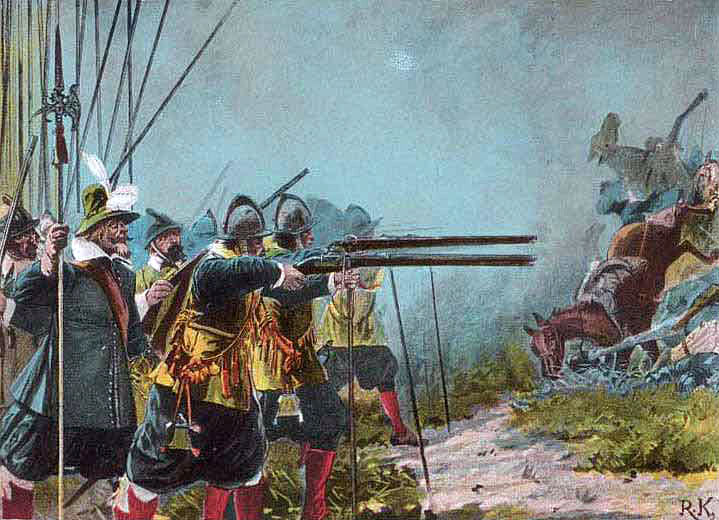
Musketeers fighting off a cavalry attack at the time of the English Civil War: Battle of Cheriton 29th March 1644
Sir William Waller followed up Balfour’s charge by bringing up the Parliamentary foot of the right wing and Hopton’s regiments came under heavy pressure.
On the Royal right, under direction from Lord Forth, Lord Hopton ordered Sir Edward Stawell’s brigade of 1,000 horse to attack. Advancing on a narrow front Stawell’s men were at a disadvantage and after half an hour of fighting under fire from the Parliamentary guns on the ridge line they began to fall back, leaving their commander severely wounded and a prisoner.
Lord Forth launched the remainder of the Royalist horse in support of Stawell’s brigade. The horse were followed by the foot on each flank. Most of the soldiers from each side were in the valley between the two ridges fighting hand to hand. Eventually Waller’s Parliamentary regiments gained the upper hand with their greater numbers and better weaponry; in particular, the heavily armoured and armed cuirassiers of Hesilrige’s ‘Lobsters’.
After several hours of this struggle the Royalist were beaten. Hopton secured the Alresford lane with 300 horse providing a retirement route for the exhausted Royalist cavalry.
On the flanks the Parliamentary foot pushed their opponents back onto the ridge line. The Royalist army fell back and made a stand on Tichbourne Down outside Alresford, but their Parliamentary opponents were in no state to exploit their success.
From there the Royalist army marched off to Basing House, where they rested for a day, and then to Reading.
Casualties at the Battle of Cheriton:
The Royalist army suffered heavy losses among its senior officers of horse, including Lord John Stewart the lieutenant-general of horse in the Western Army and Sir John Smith the major-general of horse, both killed. Sir Edward Stawell commanding a brigade of Royalist Horse was severely wounded and captured.
Royalist casualties were around 300 killed wounded and made prisoner.
Parliamentary casualties were around 200.
Probably neither figure is wholly reliable.
Follow-up to the Battle of Cheriton:
Following the Battle of Cheriton King Charles I brought the independent action of the Western Army to an end. Lord Hopton and Lord Forth marched their army to Oxford taking the Reading garrison with them.
Sir William Waller marched on to Winchester. He took the city but the castle refused to surrender. The Parliamentary army left Winchester after pillaging the city.
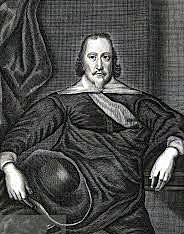
Lord Ralph Hopton, de facto Royalist commander at the Battle of Cheriton on 29th March 1644 in the English Civil War
Anecdotes and traditions from the Battle of Cheriton:
- The Royalist commander Patrick Ruthven Earl of Forth and soon to become Earl of Brentford was a Scottish officer who made his name in the Swedish Army of King Gustavus Adolphus during the Thirty Years War. Ruthven rose to high rank in the Swedish Army and was knighted by King Gustavus Adolphus. Clarendon described Lord Forth, referring to him as ‘the General’: The General-though he had been without doubt a very good officer, and had great experience, and was still a man of unquestionable courage and integrity-was now much decayed in his parts, and, with the long continued custom of immoderate drinking, dozed in his understanding, which had never been quick and vigorous-he having been always illiterate to the greatest degree that can be imagined. He was now become very deaf…’.
- At the time of the Battle of Cheriton Lord Hopton was still recovering from the injuries he suffered in the accident following the Battle of Lansdown Hill.
- Sir William Waller, commander of the Parliamentary army at the Battle of Cheriton on 29th March 1644, was known to the Parliamentary troops and supporters as ‘William the Conqueror’, in spite of his defeats at the hands of Royalist armies at the Battle of Lansdown Hill and the Battle of Roundway Down.
- The Battle of Cheriton is considered a victory for Parliament, but the authorities describing the battle acknowledge that it was marked by poor generalship on both sides.
- Clarendon was highly critical of the conduct of the Royalist horse at the Battle of Cheriton, stating: ‘The King’s horse never behaved themselves so ill as that day. For the main body of them, after they had sustained one fierce charge, wheeled about to an unreasonable distance, and left their principal officers to shift for themselves. The foot behaved themselves very gallantly, and had not only the better of the other foot, but bore two or three charges from the horse with notable courage and without being broken.’
- Clarendon commented on the quality of equipment of the two sides, saying: ‘Waller exceeded in horse, but was upon the matter equal in foot, with this only advantage, that both horse and foot were – as they were always – much better armed, no man lacking any weapon offensive or defensive that was proper for him. Sir Arthur Heselrige’s regiment of cuirassiers, called the Lobsters, were so formidable that the King’s naked and unarmed troops (amongst which few were better armed than with swords) could not bear their impression.’
- Sir John Smith: As Captain John Smith, this officer recovered the Royal Standard at the Battle of Edgehill for which he was created ‘knight banneret’ by King Charles I. Sir John Smith died of his wounds the day after the Battle of Cheriton at Andover. A marble plaque was placed in the floor of the Lucy Chapel in Christchurch Cathedral in Oxford by his nephew. The inscription reads: Here lies the body of the valiant and most worthy Gent. Sir John Smith Kt. Third son of Sir Franc: Smith of Wootton-Wawen in Ye County of Warwick Bt. (Descendant of Ye Ancient Family of Carington from Sir Michael Carington Standard Bearer to K: Richard Ye First in Ye Holy Land) who with his owne hands redeemed in Ye Battle of Edge-Hill Ye banner royall of his Most Sacred Majestie Charles 1st for which signal valour he received in Ye field Ye honour of knighthood from his Majestie. Since which time he in several Bateils gave singular testimonie of his loyaltie and courage especially in Ye memorable fight at Bramdean (Cheriton) in Hamps Ye 29 of March where having reced several wounds in psuit of Victory died at Andover Ye 30 Mar 1644 & was Ye 1 April here interd with great solemnity: aged 28. Sir Francis Throckmorton of Great Coughton in Ye County of Warwick Bt (his sister’s son) at his charge this marble hath laid.
References for the Battle of Cheriton:
The English Civil War by Peter Young and Richard Holmes
History of the Great Rebellion by Clarendon
Cromwell’s Army by CH Firth
The previous battle in the English Civil War is the First Battle of Newbury
The next battle in the English Civil War is the Battle of Cropredy Bridge
To the English Civil War index
